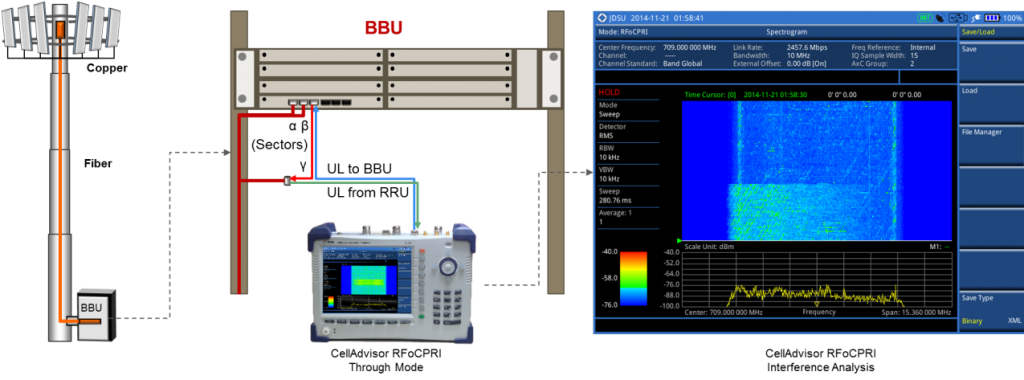How does RFoCPRI capability simplify cell-site maintenance for modern wireless networks?
Interference in cellular networks is one of the most common problems in the radio access network (RAN). As demand for cellular data continues to grow, causing proliferation of RF spectrum and amplifying RAN interference issues, managing user QoE will continue to be a big challenge for service providers. This challenge is further exacerbated by the fact that radios are now installed at the top of the tower. While the benefits of moving radio heads to the top of the tower significantly outweigh some of the challenges offered by this modern cell-site configuration, troubleshooting interference issues and optimizing RF performance has become more resource intensive and costly, and has added some safety concerns.
As discussed in previous blogs, modern cell sites have distributed base-station architecture with two key functional units:
- Baseband unit (BBU), also called radio equipment control (REC), performs the processing of the radio protocols, and interfaces between the radio network and the O&M interface.
- Remote radio head (RRH), also called radio equipment (RE), converts the digital baseband signal into the analogue signal for transmission/reception over the air.
Traditionally, the macro base station is connected to the antenna via coaxial feeder cable. In this configuration an average of 2-3dB of power is lost within the feedlines, which can be very significant. A fiber cable with virtually no RF loss, connecting the radio at the top to the BBU at bottom, offers great coverage and capacity benefits for the service provider. There are two key protocols that allow radios and BBU to communicate over the fiber link.
- Common Public Radio Interface (CPRI)
- Open Base Station Architecture Initiative (OBSAI)
The goal of the two protocols was to create an open standard interface between BBU and RRH with the aim to enable greater BBU and RRH supplier flexibility. In this blog we will discuss some of the challenges and opportunities of CPRI and how RF over CPRI (RFoCPRI) has revolutionized the architecture, deployment, maintenance, and optimization of wireless networks.
Is CPRI used by BTS manufacturers truly open standard?
Although the idea behind CPRI was to create an open standard for the internal radio interface, in reality, CPRI is neither common nor it is truly an open standard. Every BTS manufacturer implemented their own flavor of CPRI that limited the use of their radios to their BBUs. It has also created challenges for test and measurement (T&M) vendors, who now have to understand the RFoCPRI implementation of all the vendors. A T&M vendor may claim that they support RFoCPRI, and with their solution service providers and their partners can troubleshoot complex interference and PIM solutions without climbing the tower. However, without a good understanding of the CPRI implementation of all the radio vendors the solution may not offer much help in the troubleshooting process. Viavi’s RFoCPRI solution offered on CellAdvisorTM cuts across all the radio vendors and provides the same level of robust testing for all base stations.
RF interference typically affects the transmitting frequency of mobile devices (uplink) due to the devices’ limited transmission power. This interference might be generated from external sources or internally from the cell site as passive intermodulation (PIM) generated from the radio’s signal (downlink). The Viavi CellAdvisor base station analyzer with RFoCPRI technology performs interference analysis without disrupting service by monitoring the CPRI signal derived from a passive optical coupler installed next to the BBU. This coupler can support multiple fiber channels. RFoCPRI spectrum analysis provides the ability to conduct interference testing and, due to CellAdvisor’s flexible setting of CPRI profiles, analysis can be done on all RF signals transmitted, including multiple signals of the same carrier such as MIMO and multiple signals transmitted on different frequencies. Additionally, cell-site technicians working on fiber based cells do not have to climb up the tower to perform RF analysis tests.
To read more about RFoCPRI and how it enables an efficient and safe cell-site maintenance process, download our white paper.
Or, to learn more about RFoCPRI and our CellAdvisor solution, visit viavisolutions.com/rfocpri.
Kashif Hussain is the Global Solutions Marketing Manager at Viavi Solutions for the wireless business unit. With more than 19 years of wireless industry experience, Kashif’s expertise in RF, DAS, HetNets, and LTE comes from developing, managing, supporting, marketing, and consulting on major mobile communications projects. His industry experience includes various senior roles at MobileNet, Tektronix Communications and Nortel, and he has authored a patent for wireless products.






